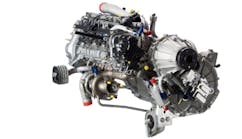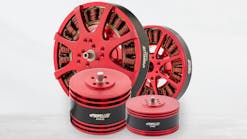Propeller Control for Turbo-Prop Engines
By Dan Ankarlo
April 1999
Controlling propeller RPM is only one of the functions of a governor installed on the turboprop engine. Indeed, other more complicated functions are performed by the governor as well. Propeller feathering, synchronizing, and beta (reverse power application) must be controlled also. Perhaps the most complicated installation for a turboprop governor is the PT-6 engine. This is due to the fact that the free turbine design of the PT-6 mandates control of the engine and propeller simultaneously. The governor must interface with the propeller, the engine fuel control unit, and the synchronizing system, simultaneously to provide desired outcomes. With so many variables interacting at the same time the potential exists for the governor to exaggerate any problems that might be caused elsewhere in the propeller/governor system. Before examining service difficulties, a basic review of the governor system will help to clarify the troubleshooting techniques given in this article.
System Description
At the heart of the system, the PT-6 governor has an internal pump that takes oil from the engine oil system and supplies it at boosted pressure and volume to the propeller servo. Some installations such as the PW100 engine system utilize a separate pump and pitch control unit for this function. In a standard PT-6 propeller engine configuration, operating oil is supplied to the governor at 40-45 psi. The governor pump elevates the pressure to 385 psi at volumes of up to 6 quarts per minute to actuate the propeller toward the low pitch or increase RPM direction. Counteracting this oil are the propeller counterweights and feather spring.
Typical PT-6 governor mounted to the engine.
Propeller speed sensing is performed by a set of spinning flyweights that are in direct drive to the reduction gear box. Speeder spring pressure counteracts the centrifugal force of the spinning flyweights to hold the metering valve (pilot valve) in a predetermined position. The position of the metering valve will determine whether or not oil is ported to or from the propeller servo. In underspeed condition, the valve ports oil to the propeller piston; reducing blade angle and increasing RPM. In overspeed condition, the valve allows oil to drain from the propeller and blade angle is increased due to counterweight and feather spring forces. This will cause a decrease in RPM. In theory, when the governor is at onspeed condition the metering valve is closed; not allowing pump oil to pass to or from the propeller and thus a constant predetermined RPM is maintained. It is important to note that on the engine the governor is always porting oil to the propeller to counteract the internal leakage where the oil transfers between the engine case and propshaft.
Feathering of the propeller, a critical function for multi-engine aircraft, is accomplished by allowing oil to drain from the propeller servo. Feather springs and counterweight forces on the propeller will force the blades into the feather position in the absence of high pressure oil. To do this, the governor makes use of either a feather lift rod or a feather plunger. The feather lift rod is centered in the control shaft on top of the governor. When the control shaft is moved to the minimum RPM position, the lift rod pulls the pilot valve into a simulated overspeed condition which allows oil to drain from the propeller. Some governor models use a feather plunger instead of a lift rod. The feather plunger does not directly contact the pilot valve, rather, it diverts governor pump oil to a feather drain tube. Feather plungers react more quickly than feather lift rods and are thus used on higher pressure operation systems such as those found on PT6-67 series engines. Use of a feather plunger bypasses normal porting and allows for quicker feathering of the prop.
"The heart of the system": Flyweight and pilot valve combination. The feather drain tube allows for quicker feathering of the propeller.
Putting the propeller into reverse mode (beta mode) and maintaining RPM control in reverse is accomplished through the use of the beta valve located at the front of the governor. The beta valve is directly connected to the propeller through the beta linkage and propeller beta ring. The primary functions of the beta valve are (1) to prevent the propeller from entering reverse uncommanded and (2) to control blade angle (and RPM) while in reverse command. As propeller blades approach reverse blade angles, the beta valve is pulled open through direct linkage to the prop. This action diverts high pressure oil from the propeller in much the same fashion as a feather lift rod. Oil is then diverted to the sump and the propeller blade angle is not allowed to travel further into reverse. Commanded reversing is accomplished by "overriding" the beta valve function. When the operator moves the power lever over the idle stop and into beta range; he resets the beta linkage and allows oil to continue to be ported to the propeller. This allows the propeller blades to travel into reverse angles.
The inherent problem with a reversing propeller system is that at some point between positive and negative blade angles, the propeller will be generating zero thrust. This is the point where the engine will be "off loaded" and attempt to overspeed. To prevent an overspeed of the engine at this point, the PT-6 governor makes use of an internal pneumatic air section. The pneumatic air section within the governor can allow PY air to bleed and thus signal the fuel control unit to decrease fuel and slow turbine speed. This ability of the governor is used in two conditions. During normal operation if a system failure allows the propeller to overspeed; the airbleed yoke inside the governor is raised and PY air is bled. This commands the fuel control unit to decrease fuel to the engine and thus reduce power. Also, during reversing operations the power turbine speed must be held to approximately 95% in order to avoid overspeed. This is accomplished by resetting the airbleed yoke manually inside the governor. When the operator commands the power lever into beta range the airbleed yoke is automatically reset through the beta linkage and engine power is thus limited to 95%.
The feather plunger operates independent of the pilot valve.
An additional function of some models of turboprop governors is to synchronize engine RPMs on multi-engine applications. Commonly known as Type II synchronizing, this system eliminates the need for rod end trimming devices. This is accomplished by use of a speed bias coil within the governor. The coil, when energized, will exert a pull on the metering valve within the governor. Changes in metering valve position are relatively minute allowing for accurate RPM control between the propellers. Of course, the operator can manually override the synchronizing system at any time. The synchronizing computer, more commonly known as the "box", will compare RPMs of the engines and increase or decrease voltage to the coils within the governors to obtain accurate speed control. Speed sensing inputs to the box can be obtained from electrical pickups on the overspeed governors or from the propellers themselves.
Although not directly controlling engine power or propeller RPM; a mention should be made about the overspeed governor within the governing system. The overspeed governor (OSG) is a separate control component located on the front of the engine. In the event of primary governor failure, the overspeed governor will limit propeller speed to somewhere between 104% and 106% of rated propeller RPM. The overspeed governor is directly in line between the primary prop governor and the propeller servo. All oil traveling from the primary prop governor to the propeller servo must travel through the overspeed governor. Using the same mechanism as the primary prop governor (i.e. flyweights and metering valve) the overspeed governor is preset to divert high pressure oil in the event of a propeller overspeed. The problem in checking overspeed operation is that since the OSG is not activated until 104%, its operation cannot be checked because the primary prop governor will hold prop RPM to 100%. Therefore, a reset condition is incorporated which will change the speed setting of the OSG to a point below 100% prop rpm. This is accomplished through the use of a solenoid valve and reset piston within the governor. During reset mode, the overspeed governor is reset to 92% of rated prop speed on most applications. This allows the governor to be checked for proper operation.
Propeller Control for Turbo-Prop Engines
By Dan Ankarlo
April 1999 The beta valve controls propeller rpm in reverse, or "beta" mode. Synchronizing is performed by an electric speed bias coil in the cover.
Troubleshooting service difficulties
Now that we have a basic understanding of the governing system, we can proceed with troubleshooting techniques. Woodward Governor of Rockford, Illinois has long been an industry leader when it comes to engineering governors. Governor failure in the field is a very rare occurrence and often the governor is cited for a problem that is caused by another component. In typical cases, governor malfunction is caused by neglect or by incorrect adjustments made in the field. After overhaul, governors are recalibrated to very exacting standards on the test bench. RPM tolerances are usually plus or minus 5 rpm; flow tolerances are specified to the tenth of a quart per minute; and air section bleed rates are measured in inches of water differential pressure. It is impossible to accurately adjust these settings in the field without proper calibration equipment. A good substitute, if a problem exists on a multi-engine aircraft, is to swap the governors from side to side. If the suspected problem follows the governor then the governor can be sent in for investigation. However, if the problem stays with the engine, other components (i.e. the propeller or fuel control unit) should be investigated. This preliminary step can save money and valuable time either by confirming the problem or ruling the governor out.
Propeller surging
The most common and least understood problem reported is that of propeller RPM surging. Surging causes can vary widely. In extreme cases of radical surge (100-400 rpm) the installation should be checked for airframe approval. Our facility has seen a number of instances where the wrong part number overspeed governor was installed and would cause interference with the primary governor (CSU). This happens as a result of the overspeed governor diverting oil prior to the primary CSU reaching 100% rpm. When the OSG diverts oil, the rpm decreases and the primary CSU attempts to increase rpm again. As rpm increases, the overspeed governor once again diverts oil to complete the cycle and thus the surging problem is exaggerated.
The PT-6 governor controls several parameters simultaneously.
Minor rpm surges can be caused by a number of factors. On occasion a governor is sent in for surging problems and it is discovered that the metering valve has become magnetized. The magnetic attraction between the metering valve, flyweights, and speed bias coil can cause small changes in valve position triggering a surge condition. The most reasonable explanation for a magnetized valve is an unreported lightning strike. Other causes for minor surging include flattened spots on the flyweights or torque fluctuations induced by the fuel control unit. In an attempt to maintain a constant rpm the governor will exaggerate these types of problems and a surging condition will result. The first step in isolating a surging problem is to check to see if the condition exists with or without the synchronizing system turned on. In all cases, a verification should be done with the synchronizer off. The next step is to swap the governors side to side to see if the problem follows the suspected unit. If the governors of a multi-engine aircraft are changed side to side and the problem remains on the same side of the aircraft, then other causes should be investigated. Often times torque fluctuations caused by the FCU will keep the governor busy attempting to stabilize rpm and a surge will result. In the case of a high time governor, the most likely causes for surging would be either worn flyweights or low pressure relief. Low pressure relief settings coupled with a high time (and high internal leakage) engine can result in surging as the governor attempts to maintain a constant rpm. There have been cases where a surging governor on one side of an aircraft was changed with the opposite governor and the surging condition disappears. This can be attributed solely to engine "gremlins."
Overspeed governor problems
Another commonly reported problem is inability to attain 100% prop rpm after a ground test is performed on the overspeed governor. In this case, the reset solenoid is stuck in the reset position and prop rpm is limited to typically 92%. The first check is to disconnect the cannon plug to the reset solenoid to ensure no electrical power is being supplied to the solenoid inadvertently. Tapping lightly on the solenoid will sometimes cause it to return to normal position. Many previously canceled flights have been continued after a technician has tapped on a reset solenoid allowing the prop to return to 100%. If the solenoid is stuck in reset mode due to foreign contamination inside, the governor will have to be removed and sent to a repair facility. Field repair or cleaning of a solenoid internally is not permitted.
The reset eccentric is a sensitive setting and field adjustment is not recomm ended. Tapping lightly on the reset solenoid will sometimes cause it to return to normal position.
Problems with engine power
Problems with loss or lack of engine power can be diagnosed easily on the aircraft. Lack of engine power can be caused by internal PY leaks within the governor, however, in most instances the governor is not at fault. Isolation of this type of problem is simple. Cap off PY air line and run the engine. Extreme caution should be exercised during engine run. Without the pneumatic air section functioning, the possibility exists of engine overspeed. If engine power still cannot be obtained with the PY capped off; the fuel control unit should be examined next. In many cases, the reset eccentric on the back side of the governor is adjusted by field technicians to adjust engine power in beta mode. Although done frequently, this practice is not recommended due to the sensitivity of the setting. During bench recalibration of a governor this setting is adjusted typically to 4 psi of differential airbleed across an orifice. There is no tolerance for this setting and it is impossible to accurately set it on the airframe. Our facility frequently receives governors for recalibration in which the reset air has been field adjusted to the point where the engine will not develop power in beta mode.
Synchronizing problems
Governor synchronizing problems can easily be investigated on the aircraft. The most common problems involve an internal short to the speed bias coil. The first step in troubleshooting these types of problems is to check output of the speed pickups. If the synchronizing box isn't receiving accurate signals then the system won't work. The next step is to ensure both governors are receiving electrical power. If they are, then checks should be made for electrical shorts on the governors themselves. Type II synchronizing governors have decals on the electrical cover that indicate which two of the three pins on the cannon plug are used. Check these pins against the cannon plug case for an electrical short.
There is an old saying that a teaspoon of oil can completely cover an airplane. Oil leaks at the front of the engine are commonly misdiagnosed as being governor leaks. International Governor was recently involved in a situation whereby the governor was blamed for a leak on a PT6-65 engine. The field technician wouldn't consider the possibility of the leak occurring elsewhere. After installation of five (yes five) different governors on the same engine; the technician finally conceded and took the time to investigate further. As it turned out, the source of the leak was a prop shaft seal. When investigating oil leaks, the easiest method is to isolate the governor. This can be done by wrapping the governor in a clear plastic bag. After engine run, if the outside of the bag is covered with oil and there is no oil inside the bag; the governor should be nonsuspect.
The most common type of oil leak on a PT6 governor is a beta valve leak. This can be isolated by wrapping the valve in masking tape and running the engine. As the beta valve moves in and out, of course, the tape will become crushed but the oil will pool inside and the leak can be verified. At International Governor, we have the most technologically advanced test stand available for PT6 governors. That is, the stand simulates the engine parameters through closed loop circuitry (a positive feedback system). Nothing, however, can actually duplicate the dynamics taking place on an actual engine. This is why it is so important to isolate an oil leak prior to sending a governor in for repair.
The decal on the electrical cover indicates which pins should have continuity.
Governor overhaul
The common factor in all governor service difficulty problems is that of neglect. Because of the high level of engineering and reliability of the governors; they tend to be overlooked. The recommended calendar TBO for all turbine governors (primary and overspeed) is six years. Woodward is continuously in the process of refining their governors by making engineering changes to them. Having the governors overhauled at the six year time interval will ensure that the most current configuration of governor will be re-installed on the engine for continued optimal performance. It should be noted that some circumstances will involve premature overhaul of the turbine engine prop governor. These cases are prop strike, lightning strike, and suspected metal in oil. It is not only mandatory by service bulletin to overhaul; but prudent as well. (Copies of Woodward SB 33580 can be obtained by calling International Governor at 303-464-0043). The internal components of a typical PT6 prop governor are fragile if mistreated. Severe and costly damage can be done by continued operation without overhaul after any of the above mentioned incidents. Our facility has seen a number of cases during this past year whereby governors have been run after such an incident. In several of the cases, the metering valve thrust bearing has come apart and injected ball bearings into the engine. The end result is a mandatory metal in oil inspection for the engine. Cost between $30K-40K. These inspections could have been avoided if proper precautions had been taken.
In all, the turbine engine propeller governing system is a well designed system that is asked to control many variables at once. If proper care and timely attention are devoted to the system; it will give years of reliable service. Because the governor is a highly visible component on the engine, it is often blamed for service problems. Simple troubleshooting techniques can allow the field technician to quickly and accurately diagnose engine control problems; whether or not they are caused by the governor.




